Lugh had many roles in Irish mythology such as a powerful deity, human being, vassal or king, sun god, or master craftsman. Like with many pagan religions, it can be difficult to separate oral histories from myths. Lugh is certainly considered one of the most powerful of the ancient Celtic gods and goddesses. But he may also have been a historical figure who was deified in later years.
Table of Contents
Who Was Lugh?
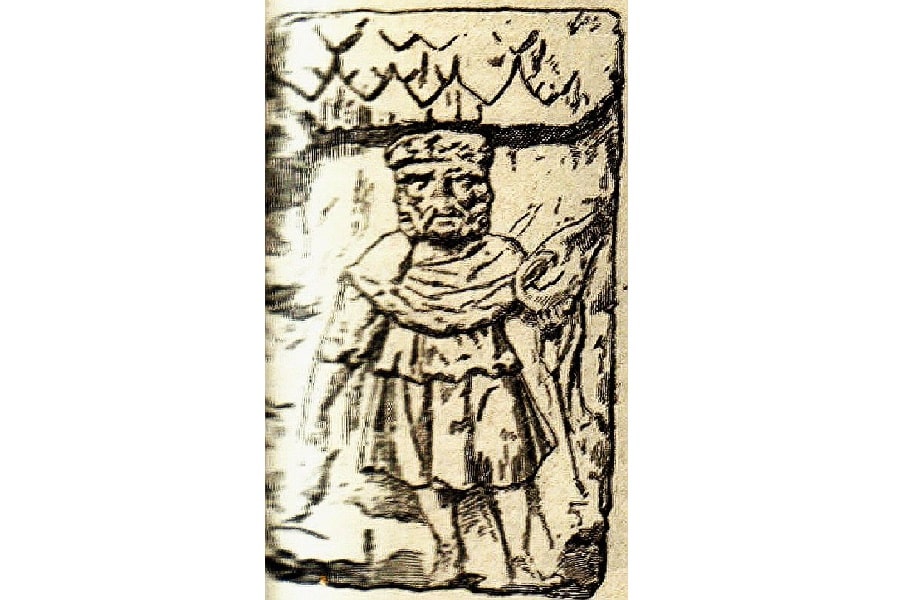
Lugh was a very important figure in Irish mythology. Considered a master craftsman and a wise king, it is difficult to tell exactly which domains he ruled over. According to some sources, he was a sun god. Most texts associate him with art and craftsmanship, weaponry, law, and truth.
Lugh was the son of Cian, the physician of the Tuatha Dé Danann, and Ethniu or Ethliu. His half Tuatha Dé Danann and half-Fomorian lineage meant that it placed him in an interesting position. Since the two clans were always warring against each other, like Bres, Lugh had to choose between his mother’s and his father’s family. Unlike Bres, he chose the Tuatha Dé Danann.
Warrior and King of the Tuatha Dé Danann
Lugh is considered a savior and hero in Celtic mythology since he helped the Tuatha Dé Danann to win against the Fomorians. The ancient Celts considered the Tuatha Dé Danann their ancestors and the forefathers of the Irish people. It may have been that these heroes of legend were once men who were later deified. It is also equally possible that he was an ancient all-wise and omniscient Celtic god that the later generations adapted as a mythic hero.
Whatever the case may have been, the gods of Celtic mythology are very close to the hearts of the Irish people. They were their ancestors, their chiefs, and their kings. Lugh was not just a king of the Tuatha Dé Danann, but also the first Ollamh Érenn or Chief Ollam of Ireland. Ollam means poet or bard. All the High Kings of Ireland had a Chief Ollam to cater to them and their court. His status was almost equal to that of the High King, which shows us how highly the Irish valued literature and the arts.
Meaning of the Name Lugh
There may have been two roots for the name ‘Lugh.’ Most modern scholars think that it derives from the Proto Indo-European root word ‘leugh’ which means ‘to bind by oath.’ This ties in with the theories that he was also the god of oaths, truth, and contracts.
However, earlier scholars theorized that his name derived from the root word ‘leuk.’ It was also a Proto Indo-European word that meant ‘flashing light,’ giving rise to speculation that Lugh may have been a sun god at some point.
Modern scholars do not find this theory convincing because of phonetic reasons. The Proto Indo-European ‘k’ did not give rise to the Celtic ‘g’ and this theory does not stand up to criticism.
Epithets and Titles
Lugh also bore many epithets and titles, which allude to his different skills and powers. One of the names that the ancient Celts had for him was Lámfada, which means ‘long arm.’ This was possibly a reference to his skill with and fondness for spears. It could also mean ‘artful hands,’ referring to his reputation as a master craftsman and artist.
He was also called Ildánach (‘skilled in many arts’) and Samildánach (‘skilled in all the arts’). Some of his other names are mac Ethleen/Ethnenn (meaning ‘son of Ethliu/Ethniu’), mac Cien (meaning ‘son of Cian’), Lonnbéimnech (meaning ‘fierce striker’), Macnia (meaning ‘youthful warrior’ or ‘boy hero’), and Conmac (meaning ‘hound-son’ or ‘son of hound’).
Skills and Powers
The god Lugh was a bundle of contradictions. He was a fierce warrior and fighter, wielding his famed spear with great skill. He is usually described as looking very youthful and handsome and was said to be a master horseman.
Apart from being a great warrior, Lugh was also considered a craftsman and inventor. He is said to have invented the Irish board game of fidchell, as well as started the Assembly of Talti. Named after his foster mother Tailtiu, the Assembly was an Irish version of the Olympic games where horse racing and various displays of martial arts were practiced.
As per his name, Lugh was also the god of oaths and contracts. He was said to enact justice on wrongdoers and his justice was often merciless and swift. There were aspects of a trickster god in the mythology of Lugh. This seems opposed to his role as an arbiter of justice but Lugh was not above-using tricks to get his way.
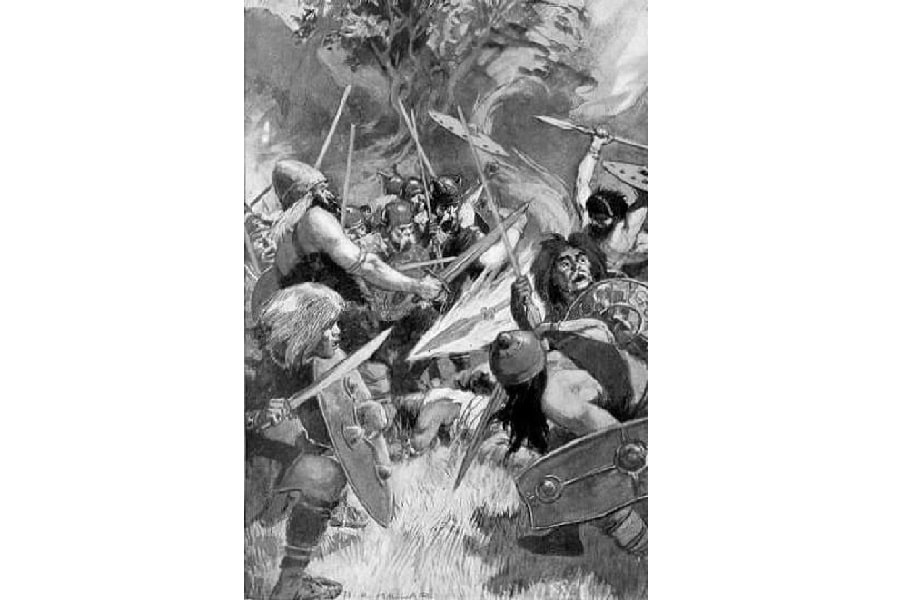
Lugh and Bres: Death by Trickery
Lugh’s killing of Bres attests to this fact. Even though he defeated Bres and spared his life in battle, Lugh decided to get rid of him after a few years, afraid that Bres would start making trouble again. He created 300 wooden cows and filled them with a red, poisonous liquid. After ‘milking’ these cows, he offered the buckets of liquid to Bres to drink. As a guest, Bres was not allowed to reject Lugh’s hospitality. Thus, he drank the poison and was immediately killed.
Family
Lugh was the son of Cian and Ethniu. Through Ethniu, he was the grandson of the great and formidable Fomorian tyrant Balor. He may have had either a daughter or a sister known as Ebliu. Lugh had several foster parents. His foster mother was Tailtiu, the queen of Fir Bolg, or the ancient queen Duach. Lugh’s foster father was Manannán mac Lir, the Celtic sea god, or Goibhniu, the smith of the gods. They both trained him and taught him many skills.
Lugh had more than one wife or consort. His first wives were Buí or Bua and Nás. They were the daughters of the King of Britain, Ruadri Ruad. Buí is said to have been buried at Knowth and Nás at Naas in Kildare County, a place named after her. The latter gave him a son, Ibic of the Horses.
However, the most famous of Lugh’s sons was the hero of Irish folklore, Cú Chulainn, by the mortal woman Deichtine.
Father of Cú Chulainn
Deichtine was the sister of king Conchobar mac Nessa. She was married to another man but legend says that the son she bore was Lugh’s. Cú Chulainn, also called the Hound of Ulster, plays a prominent part in ancient Irish myths, as well as Scottish and Manx ones. He was a great warrior and at only seventeen single-handedly defeated Ulster against the armies of Queen Medb. Cú Chulainn defeated Medb and negotiated peace for a time but alas, the war between the two broke out seven years later and he was killed. The Ulster Cycle tells the tales of a great hero.
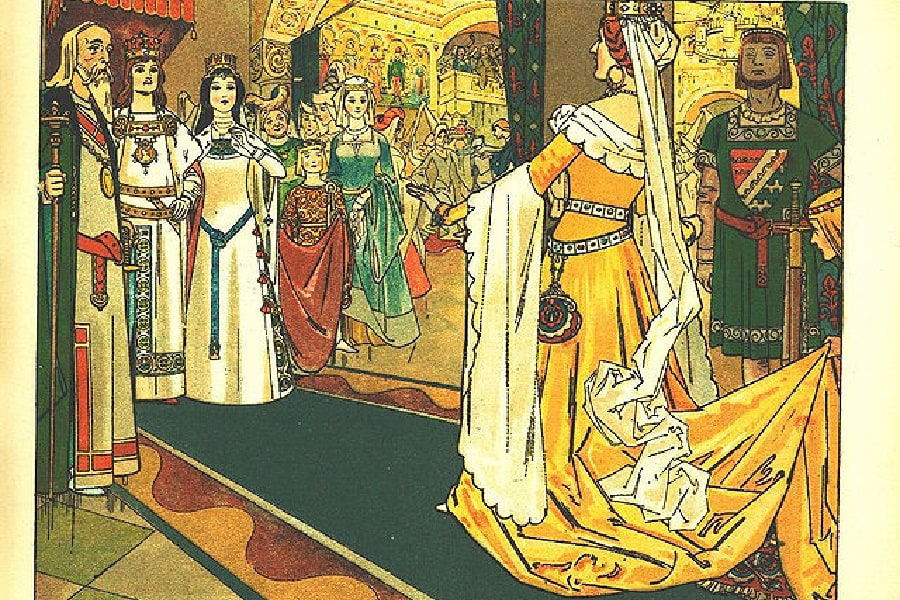
Symbolism and Possessions
Lugh was given many magical items and possessions that he was often depicted with. These items were the source of some of the epithets bestowed upon the Celtic deity. Mentions of these items can be found in the narrative Fate of the Children of Tuireann.
Spear and Slingshot
The spear of Lugh was one of the Four Treasures of the Tuatha Dé Danann. The spear was called the Spear of Assal and Lugh obtained it as a fine imposed upon the children of Tuirill Biccreo (another name for Tuireann). If one said the incantation ‘ibar’ while casting it, the spear always hit its mark. The incantation ‘athibar’ would make it come back. The incantations meant ‘yew’ and ‘re-yew’ and yew was the wood with which the spear was supposedly made.
In another account, Lugh demanded the spear from the king of Persia. The spear was called Ar-éadbair or Areadbhair. It always needed to be kept in a pot of water while not in use because the tip of the spear would burst into flames otherwise. In translation, this spear is called a ‘slaughterer.’ The spear was said to be always thirst for blood and it never got tired of slaying the ranks of enemy soldiers.
Lugh’s weapons of choice appeared to be projectile weapons since he killed his grandfather Balor with a slingshot. He used a stone thrown from his slingshot to pierce through the evil eye of Balor. Some old poems state that what he used was not a stone but a tathlum, a missile formed from the blood of various animals and the sands of the Red Sea and Armorian Sea.
The final one of Lugh’s weapons is the Freagarthach or the Fragarach. This was the sword of the sea god Manannán mac Lir, which he gave as a gift to his foster son Lugh.
Horse and Boat
Manannán mac Lir also gave to Lugh a famed horse and a boat. The horse was called Enbarr (Énbarr) or Aonbharr and it could travel over both water and land. It was faster than the wind and had been gifted to Lugh, to use at his will. The children of Tuireann asked Lugh if they could use the horse. Lugh said that the horse had only been loaned to him and belonged to Manannán mac Lir. He refused on the grounds that it was not right to loan a horse.
Lugh’s coracle or boat, however, belonged to him. It was called Wave Sweeper. Lugh had to lend this to the children of Tuireann and had no excuses to refuse their request.
Lugh also demanded the fine of a pair of horses, Gainne and Rea, from the sons of Tuirill Biccreo. It was said that the horses had originally belonged to the king of Sicily.
Hound
The story, “Fate of the Children of Tuireann,” about Lugh explains that the hound was named Failinis and came into Lugh’s possession as a forfeit or fine from the sons of Tuirill Biccreo. Originally belonging to the king of Ioruaidhe, the hound is also mentioned in one of the Ossianic Ballads. The hound is either called Failinis or Ṡalinnis in the ballad, accompanying a group of people encountered by the famed Fianna. It is described as an ancient greyhound who had been the companion of Lugh and had been given to him by the sons of Tuireann.
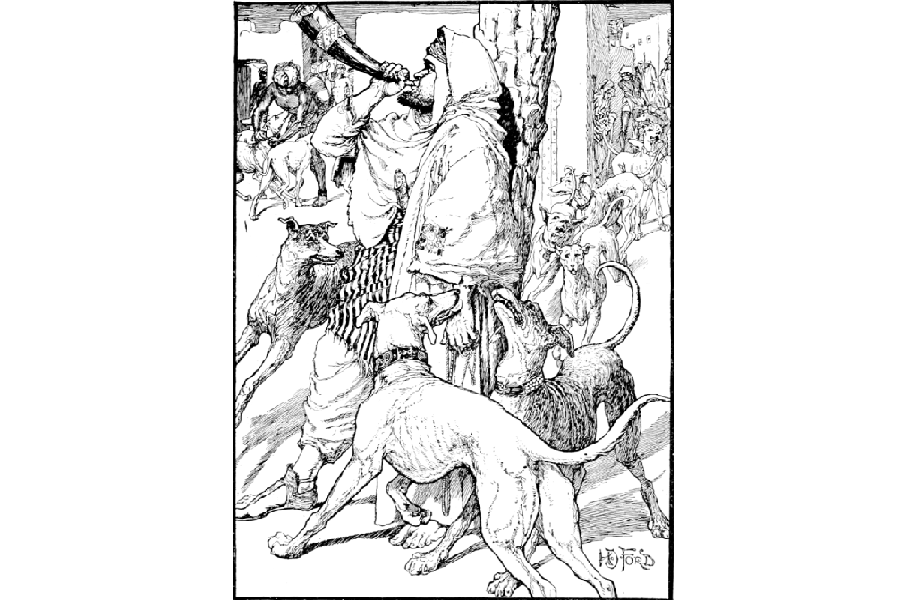
Mythology
Lugh is, in many ways, an Irish cultural hero just as much as he is a deity. Some of the stories revolving around him are not unlike the stories of the demigods found in Greek mythology. Neither fully human nor completely celestial, he plays an extremely important role in Irish literature and myth. Fact and fiction are difficult to separate when it comes to this figure.
Even today, there is a tribe called the Luigni, living in County Meath and County Sligo in the northern parts of Ireland, who call themselves descendants of Lugh. This claim would be impossible to verify, even if Lugh had been an actual historical figure, given the lack of written records.
The Birth of Lugh
Lugh’s father was Cian of the Tuatha Dé Danann and his mother was Ethniu, daughter of Balor, of the Fomorians. According to most sources, their marriage was dynastic and arranged after the two tribes made an alliance with each other. They had a son and gave him to Lugh’s foster mother Tailtiu to raise.
However, there is also a folktale in Ireland that tells of a grandson of Balor who grew up to kill his grandfather. While the child was never named in the story and the manner in which Balor was killed was different, the circumstances make it clear that it was Lugh who the tale is about.
In the story, Balor finds out about the prophecy that his own grandson will kill him. He locks up his daughter in a tower on an island called Tory Island to prevent the prophecy from coming true. Meanwhile, on the mainland, Lugh’s father, who is named Mac Cinnfhaelaidh in the story, has his cow stolen by Balor for her abundant milk. Wanting revenge, he vows to destroy Balor. He asks for the help of a fairy woman called Birog to magically transport him to Ethniu’s tower.
Once there, Mac Cinnfhaelaidh seduces Ethniu, who gives birth to triplet boys. Enraged, Balor gathers the three up in a sheet and gives them to a messenger to drown in a whirlpool. On the way, the messenger drops one of the babies in the harbor, where he is rescued by Birog. Birog gives the child to his father, who in turn gives it to his brother, the smith, to raise. This matches up with Lugh’s story since Lugh was fostered by his uncle, Giobhniu, the smith of the Celtic gods.
Triple deities were found often in Celtic mythology since three was thought to be a powerful magical number. The goddess Brigid too was thought to be one of three sisters. Cian was also one of three siblings.
Joining the Tuatha Dé Danann
Lugh decided to join the Tuatha Dé Danann as a young man and traveled to Tara to the court of the then-king Nuada. The story goes that Lugh was not allowed in by the doorman since he did not have any exclusive talents to offer to the king.
In turn, Lugh offers his services as a smith, wright, swordsman, hero, champion, poet, harpist, historian, craftsman, and sorcerer. The doorman rejects him every time, stating that King Nuada already has one of those. Finally, Lugh asks if he has someone with all those talents. The doorman has to admit that the king does not. Lugh is allowed inside.
Lugh then challenges the champion Ogma to a flagstone throwing competition and wins. He also entertains the court with his harp. Amazed at his talent, the king appoints him as the Chief Ollam of Ireland.
The Tuatha Dé Danann were being oppressed by the Fomorians under the rule of Lugh’s grandfather Balor at this time. Lugh was shocked that they so meekly submitted to the Fomorians without fighting back. Seeing the skills of the young man, Nuada wondered if he would be the one to lead them to victory. Subsequently, Lugh was given command over the Tuatha Dé Danann and he began to make preparations for war.
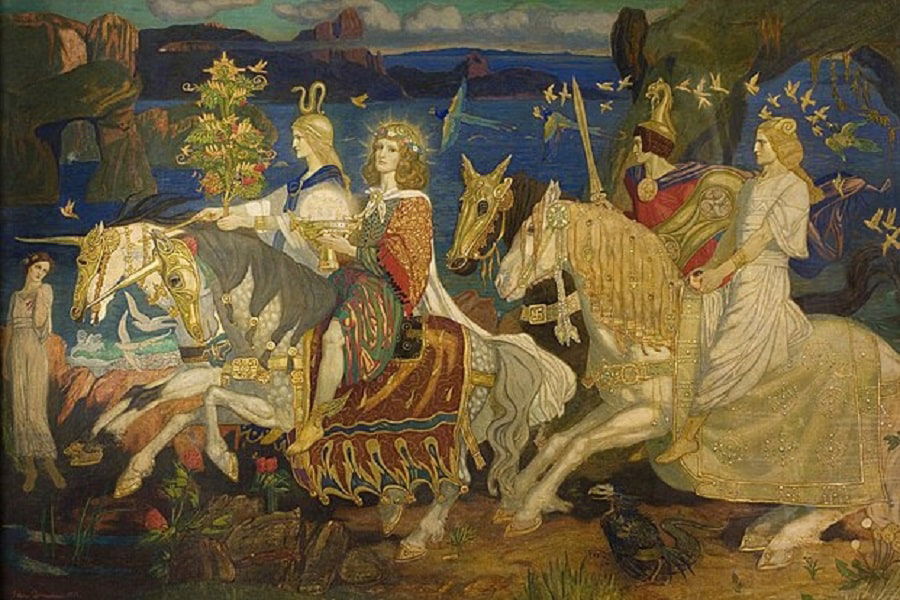
Lugh and the Sons of Tuireann
This is one of the most well-known ancient Irish tales about Lugh. According to this story, Cian and Tuireann were old enemies. The three sons of Tuireann, Brian, Iuchar, and Iucharba plotted to kill Cian. Cian attempts to hide from them in the form of a pig but is found. Cian tricks them into allowing him to return to human form. This means that Lugh would have the right to demand compensation for a father, not a pig.
When the three brothers try to bury Cian, the ground spits the body out twice. Even after they manage to bury him, the ground informs Lugh that it is the burial site. Lugh then invites the three to a feast and asks them what they think the compensation for a father’s murder should be. They say that death would be the only fair demand and Lugh agrees with them.
Lugh then accuses them of the murder of his father. He sets them a series of almost impossible quests to complete. They complete all of them successfully except the last one, which is sure to kill them. Tuirneann pleads for mercy for his sons but Lugh says they must complete the task. They are all fatally wounded and Lugh does not agree to let them use the magical pigskin to heal themselves. Thus, the three sons of Tuireann all die and Tuireann is left to mourn them and grieve over their bodies.
The Battle of Magh Tuireadh
Lugh led the Tuatha Dé Danann to battle against the Fomorians with the help of the magical artifacts that he had collected from the sons of Tuireann. This was called the Second Battle of Magh Tuireadh.
Lugh appeared at the head of the army and gave such a speech that every warrior felt that their spirits had become equal to a king’s. He individually asked each man and woman what skills and talents they would bring to the battlefield.
Nuada, the king of the Tuatha Dé Danann, died during this conflict at the hands of Balor. Balor wreaked havoc among Lugh’s armies, opening his terrible and poisonous evil eye. Balor defeated him by using a slingshot to shoot out Balor’s evil eye from the back of his head. As Balor died, chaos broke out amongst the ranks of the Fomorians.
At the end of the battle, Lugh discovered Bres alive. The unpopular former king of the Tuatha Dé Danann begged for his life to be spared. He promised that the cows of Ireland would always provide milk. The Tuatha Dé Danann refused his offer. Then he promised to provide four harvests every year. Again, the Tuatha Dé Danann refused his offer. They said one harvest a year was enough for them.
Lugh finally decided to spare the life of Bres on the condition that he would teach the Tuatha Dé Danann the ways of agriculture, how to sow, reap, and plow. Since various myths say that Lugh killed Bres after a while, it is not clear what exactly prevented him from killing Bres at that moment.

The Death of Lugh
According to some sources, after the Second Battle of Magh Tuireadh, Lugh became the king of the Tuatha Dé Danann. He was said to have ruled for forty years before he was killed. His death came about when one of Lugh’s wives, Buach, had an affair with one of the sons of the Dagda, Cermait.
Lugh kills Cermait as revenge. Cermait’s three sons, Mac Cuill, Mac Cecht, and Mac Gréine, come together to kill Lugh to avenge their father. According to the stories, they spear him through the foot and drown him in a lake County Westmeath, Loch Lugborta. Lugh’s body is said to have been later recovered and buried on the shores of the lake, under a cairn.
After his death, like the other gods, Lugh lived in Tír na nÓg (meaning ‘land of the young’), the Celtic otherworld. Eventually, the Dagda resurrected Cermait, bringing him back to life with a touch from the smooth, healing end of his staff.
Festivals and Sites Associated with Lugh
The Celtic god lent his name to an important festival, the Lughnasa, which Lugh is said to have dedicated to Tailtiu. It is still celebrated today by neo-pagans, especially in and around the town of Telltown, named after Tailtiu.
Lugh also gave his name to certain places in Europe, foremost among them being Lugdunum or Lyon in France and Luguvalium or Carlisle in England. These were the Roman names for those places. County Louth in Ireland is named after the village Louth, which in turn is named for the Celtic god.
Lughnasa
The Lughnasa took place on the first day of August. In the Celtic world, this festival, taking place at the beginning of the harvest season, was meant to celebrate autumn. The rituals mostly consisted of feasting and merrymaking, various games in the honor of Lugh and Tailtiu, and a long walk up a hill after the feast. It was at the festival that the Tailteann games were held. The festival also involved marriages or couples making love, since it was a festival meant to celebrate fertility and a bountiful harvest after all.
Lughnasa, along with Samhain, Imbolc, and Beltane, made up the four most important holidays of the ancient Celts. Lughnasa marked the midpoint between the summer solstice and the autumn equinox.
READ MORE: Ancient Civilizations Timeline: 16 Oldest Known Cultures From Around The World
While Lugus and not precisely Lugh appears to have been the namesake of the festival, it has been widely understood that these were two names for the same deity. Lugh was his Irish name while Lugus was the name he was known by in Britain and Gaul.
Holy Sites
The holy sites associated with Lugh are not exactly cut and dry, in the way that the holy sites for other Celtic deities like Brigid may be. There is Telltown, where Tailtiu is said to have been buried and which is supposed to be the birthplace of the Lughnasa festival.
There are also theories that Newgrange in County Meath in Ireland is where Lugh’s burial mound may be found. There is a lot of folklore about Newgrange, including the tales that it is one of the entrances to the Celtic otherworld and the dwelling place of the Tuatha Dé Danann.
However, it is unlikely that the burial mound of Lugh would have been near Newgrange, had he even existed, since Newgrange is not near Loch Lugborta. A more probable location is the Hill of Uisneach, the sacred center of Ireland.
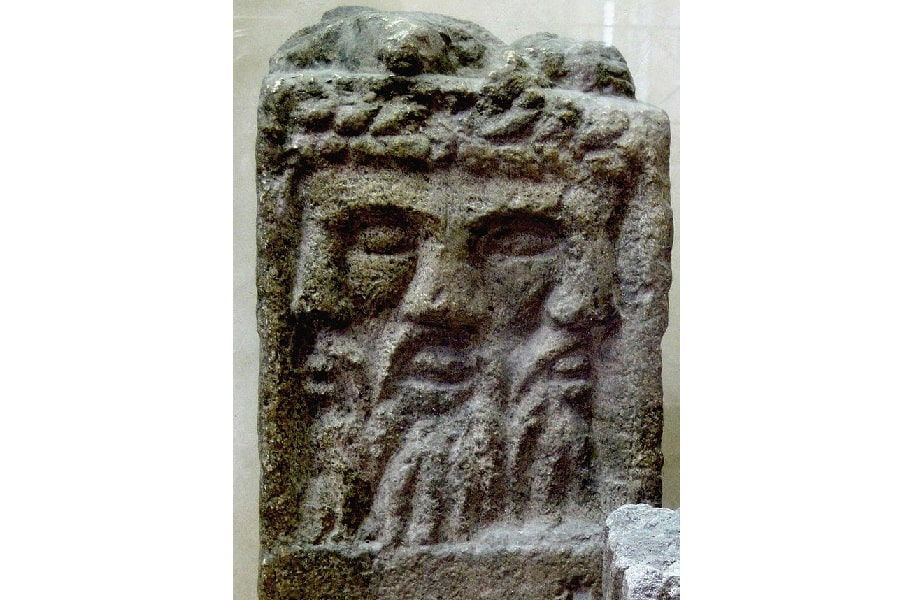
Association with Other Gods
Being one of the main Celtic gods, variations of Lugh were found all over Britain and Europe in general. He was known as Lugus in the rest of Britain and in Gaul. He was also very similar to the Welsh deity known as Lleu Llaw Gyffes. All of these deities were primarily associated with rulership and skillfulness, but there were also associations with the sun and light.
Lugh also had some associations with the Norse god, Freyr, since they both had boats that could change sizes. Freyr’s father, like Lugh’s foster father, was the god of the sea.
When Julius Caesar and the other Romans began their conquest of Western Europe and the British Isles, they began to associate many of the local deities with their own gods. They thought of Lugh as a variation of the Roman god, Mercury, who was the messenger of the gods and had a playful, trickster nature. Julius Caesar described the Gaulish version of Lugh, whom he associated with Mercury, as the inventor of all arts. He further stated that this deity was the most important of all the Gaulish deities.
The Legacy of Lugh
Another interesting aspect of Lugh is that he may have evolved into something quite different over the years. As Christianity rose in importance and the Celtic gods became less and less significant, Lugh may have transformed into a form called Lugh-chromain. This meant ‘stooping Lugh’ and was a reference to him now inhabiting the underground world where the Celtic sidhe or fairies lived. This was where all the old Irish gods were relegated to as the people embraced a new religion and new traditions. From there, he further developed into the leprechaun, the distinctive goblin-imp-fairy creature that is so centrally associated with Ireland.